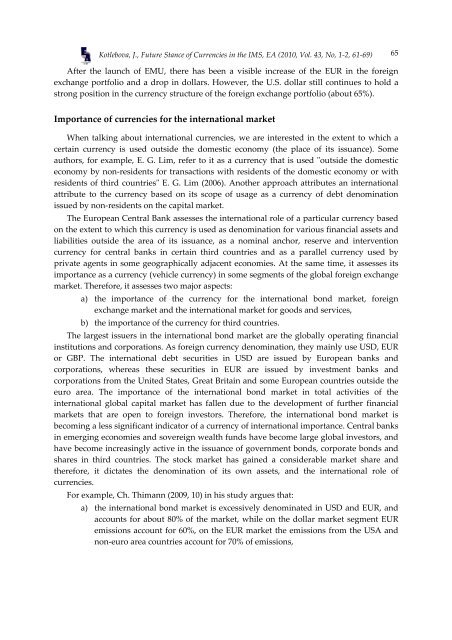Twice a Year Scientific Journal
Twice a Year Scientific Journal
Twice a Year Scientific Journal
Create successful ePaper yourself
Turn your PDF publications into a flip-book with our unique Google optimized e-Paper software.
Kotlebova, J., Future Stance of Currencies in the IMS, EA (2010, Vol. 43, No, 1-2, 61-69) 65<br />
After the launch of EMU, there has been a visible increase of the EUR in the foreign<br />
exchange portfolio and a drop in dollars. However, the U.S. dollar still continues to hold a<br />
strong position in the currency structure of the foreign exchange portfolio (about 65%).<br />
Importance of currencies for the international market<br />
When talking about international currencies, we are interested in the extent to which a<br />
certain currency is used outside the domestic economy (the place of its issuance). Some<br />
authors, for example, E. G. Lim, refer to it as a currency that is used ʺoutside the domestic<br />
economy by non-residents for transactions with residents of the domestic economy or with<br />
residents of third countriesʺ E. G. Lim (2006). Another approach attributes an international<br />
attribute to the currency based on its scope of usage as a currency of debt denomination<br />
issued by non-residents on the capital market.<br />
The European Central Bank assesses the international role of a particular currency based<br />
on the extent to which this currency is used as denomination for various financial assets and<br />
liabilities outside the area of its issuance, as a nominal anchor, reserve and intervention<br />
currency for central banks in certain third countries and as a parallel currency used by<br />
private agents in some geographically adjacent economies. At the same time, it assesses its<br />
importance as a currency (vehicle currency) in some segments of the global foreign exchange<br />
market. Therefore, it assesses two major aspects:<br />
a) the importance of the currency for the international bond market, foreign<br />
exchange market and the international market for goods and services,<br />
b) the importance of the currency for third countries.<br />
The largest issuers in the international bond market are the globally operating financial<br />
institutions and corporations. As foreign currency denomination, they mainly use USD, EUR<br />
or GBP. The international debt securities in USD are issued by European banks and<br />
corporations, whereas these securities in EUR are issued by investment banks and<br />
corporations from the United States, Great Britain and some European countries outside the<br />
euro area. The importance of the international bond market in total activities of the<br />
international global capital market has fallen due to the development of further financial<br />
markets that are open to foreign investors. Therefore, the international bond market is<br />
becoming a less significant indicator of a currency of international importance. Central banks<br />
in emerging economies and sovereign wealth funds have become large global investors, and<br />
have become increasingly active in the issuance of government bonds, corporate bonds and<br />
shares in third countries. The stock market has gained a considerable market share and<br />
therefore, it dictates the denomination of its own assets, and the international role of<br />
currencies.<br />
For example, Ch. Thimann (2009, 10) in his study argues that:<br />
a) the international bond market is excessively denominated in USD and EUR, and<br />
accounts for about 80% of the market, while on the dollar market segment EUR<br />
emissions account for 60%, on the EUR market the emissions from the USA and<br />
non-euro area countries account for 70% of emissions,
















